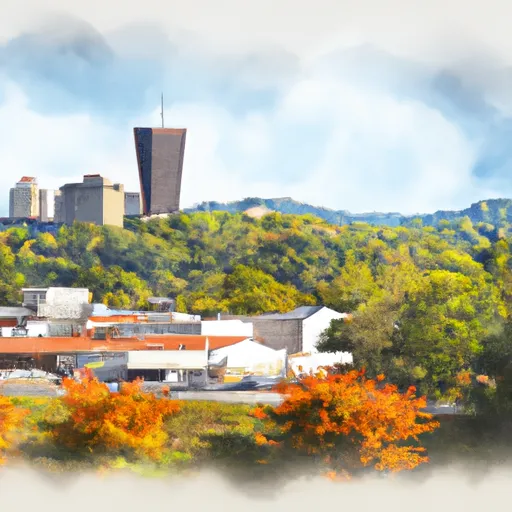-
 Snoflo Premium
Snoflo Premium
Get unlimited access to all our content
With no Ad interruptions! - Start Your Free Trial Login with existing account
Fall-Branch
Eden Index
Climate
8.3
•
Recreation
3.7
•
Community
1.1
•
Safeguard
4.9/10

Fall Branch is a small town located in Northeast Tennessee with a humid subtropical climate. Summers are hot and humid, while winters are mild but can sometimes bring snow and ice. The town has a small stream, Fall Branch Creek, which is a tributary of the Nolichucky River. The hydrology constituents of the creek are relatively clean, with low levels of pollutants. Outdoor recreation opportunities in the area include hiking and biking on the nearby Appalachian Trail, fishing and kayaking on the Nolichucky River, and exploring the local parks and nature preserves. The town also has several golf courses and a community center with a variety of sports facilities.
What is the Eden Index?
The Snoflo Eden Index serves as a comprehensive rating system for regions, evaluating their desirability through a holistic assessment of climate health, outdoor recreation opportunities, and natural disaster risk, acknowledging the profound impact of these factors on livability and well-being.
Climate Health Indicator (CHI): 8.3
Fall-Branch receives approximately
1132mm of rain per year,
with humidity levels near 83%
and air temperatures averaging around
14°C.
Fall-Branch has a plant hardyness factor of
7, meaning
plants and agriculture in this region tend to thrive during the non-winter months.
By considering the ideal temperature range, reliable water supplies, clean air, and stable seasonal rain or snowpacks, the Climate Health Indicator (CHI) underscores the significance of a healthy climate as the foundation for quality living.
A healthy climate is paramount for ensuring a high quality of life and livability in a region, fostering both physical well-being and environmental harmony. This can be characterized by ideal temperatures, reliable access to water supplies, clean air, and consistent seasonal rain or snowpacks.
Weather Forecast
Streamflow Conditions
French Broad-Holston
Area Rivers
French Broad-Holston
Snowpack Depths
French Broad-Holston
Reservoir Storage Capacity
French Broad-Holston
Groundwater Levels
Recreational Opportunity Index (ROI): 3.7
The Recreational Opportunity Index (ROI) recognizes the value of outdoor recreational options, such as parks, hiking trails, camping sites, and fishing spots, while acknowledging that climate plays a pivotal role in ensuring the comfort and consistency of these experiences.
Access to outdoor recreational opportunities, encompassing activities such as parks, hiking, camping, and fishing, is crucial for overall well-being, and the climate plays a pivotal role in enabling and enhancing these experiences, ensuring that individuals can engage in nature-based activities comfortably and consistently.
Camping Areas
| Campground | Campsites | Reservations | Toilets | Showers | Elevation |
|---|---|---|---|---|---|
| Table Rock State Park | 100 | 1,153 ft | |||
| Mount Pisgah - Blue Ridge Parkway | None | 4,859 ft | |||
| Lake Powhatan | 97 | 2,196 ft | |||
| North Mills River | 37 | 2,227 ft | |||
| Davy Crockett Birthplace | 88 | 1,392 ft | |||
| Persimmon Ridge City Park | 45 | 1,733 ft | |||
| Old Forge | 15 | 2,154 ft | |||
| Davidson River | 160 | 2,166 ft | |||
| Pleasant Ridge County Park | 25 | 1,173 ft | |||
| Horse Creek Rec Area | 34 | 1,759 ft |
Nearby Ski Areas
Catastrophe Safeguard Index (CSI):
The Catastrophe Safeguard Index (CSI) recognizes that natural disaster risk, encompassing floods, fires, hurricanes, and tornadoes, can drastically affect safety and the overall appeal of an area.
The level of natural disaster risk in a region significantly affects safety and the overall livability, with climate change amplifying these risks by potentially increasing the frequency and intensity of events like floods, fires, hurricanes, and tornadoes, thereby posing substantial challenges to community resilience and well-being.
Community Resilience Indicator (CRI): 1.1
The Community Resilience Indicator (CRI) recognizes that education, healthcare, and socioeconomics are crucial to the well-being of a region. The CRI acknowledges the profound impact of these elements on residents' overall quality of life. By evaluating educational resources, healthcare accessibility, and economic inclusivity, the index captures the essential aspects that contribute to a thriving community, fostering resident satisfaction, equity, and social cohesion.

